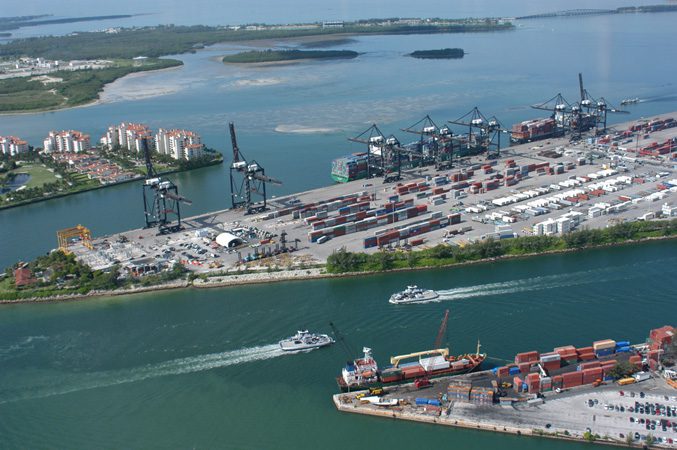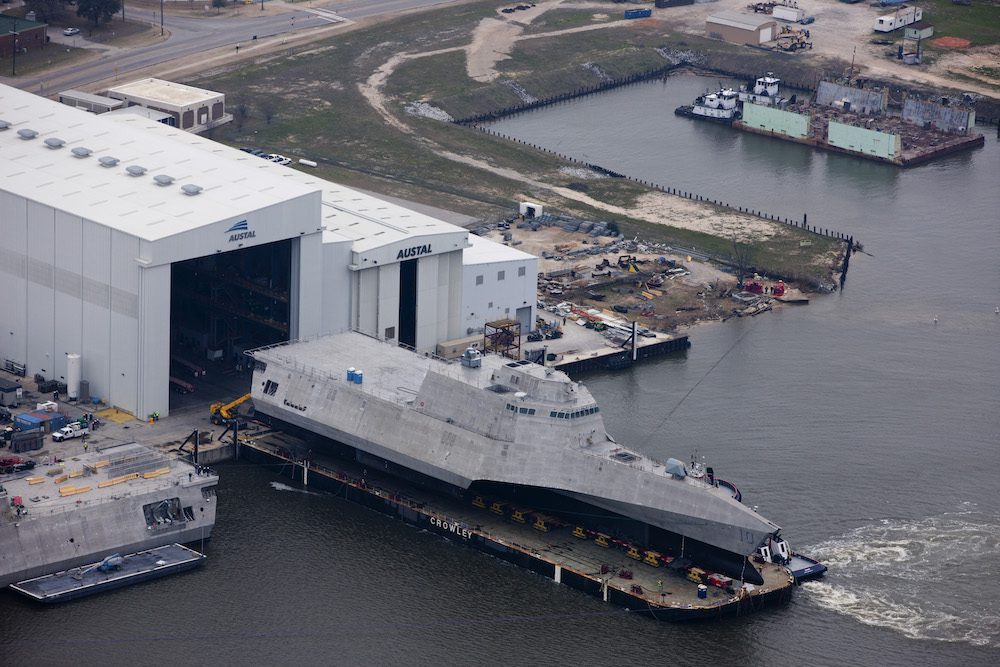PortMiami file photo.
By Toluse Olorunnipa
Sept. 10 (Bloomberg) — The port of Miami, the world’s largest cruise-ship hub, is selling a record $389 million of debt to boost its cargo business as the Panama Canal expands. Investors are balking, as the plan would triple the facility’s bond load in four years.
With this week’s borrowing, the port joins East Coast rivals taking on debt to finance upgrades in advance of the canal project’s completion, set for 2015. A wider passage would allow larger cargo ships access to cities such as New York, Baltimore, and Savannah, Georgia.
Even as Miami’s port bets that capital improvements such as dredging will add revenue, Moody’s Investors Service cut its rating to four steps above junk last month, citing the growing debt burden. Bondholders showed concern by pushing the extra yield over benchmark debt close to the highest since February.
“It’s a borderline credit, it was just recently downgraded and the trends don’t look good at this point,” said Burt Mulford, a portfolio manager at St. Petersburg, Florida-based Eagle Asset Management Inc., which oversees about $2 billion of municipal debt. “We’re taking a pass.”
Expansion Risk
For U.S. ports, the canal expansion presents risk and opportunity as the destinations vie for business. Sixty-three of 82 ports surveyed by the American Association of Port Authorities plan to invest $46 billion for infrastructure from 2012 to 2016, according to Randy Gerardes, an analyst with Wells Fargo Securities. That compares with a combined $30.1 billion spent from 1946 through 2005.
In Miami, which has been losing cruise-ship revenue to rivals such as nearby Fort Lauderdale, the issuance will finance a $220 million deep-dredging project, a $1 billion tunnel system to ease transportation to interstate highways and a $50 million plan to link the port to rail lines.
The $5.25 billion canal expansion, to be completed in 2015, will allow cargo ships carrying the equivalent of 13,000 20-foot containers to traverse the 50-mile (80-kilometer) passage. The vessels are more than double the size of the largest ships currently passing through the locks.
“When Panama comes on line, we in Miami will be big-ship ready,” Bill Johnson, director of the port, said by telephone.
‘Best Investment’
He dismissed concern that the rising debt load increases risk for investors, calling the port “the best investment in the world.”
The port relies on cruise operations for about 44 percent of revenue, compared with 40 percent from cargo, offering documents show.
Moody’s cut the seaport’s rating one level last month to A3. By 2017, net revenue from the port won’t be able to cover its bonds and debt issued by Miami-Dade County on its behalf, said David Jacobson, a Moody’s spokesman in New York. The port may have to use reserves, Jacobson said.
The seaport’s municipal debt — which includes revenue bonds and general obligations issued by the county — is about $260 million, according to county documents. The county has also loaned the seaport $325 million.
Extra Padding
The largest portion of Miami-Dade County seaport debt was issued in 1995 and matures in October 2015, data compiled by Bloomberg show. The securities are also backed by National Public Finance Guarantee Corp., a unit of MBIA Inc.
The bonds traded Aug. 23 at an average yield of 6.06 percent, or about 5.5 percentage points more than benchmark munis, close to the biggest spread since February, data compiled by Bloomberg show.
The planned work will deepen the harbor to at least 50 feet (15 meters), from 42 feet, offering documents say. That will allow the largest ships to dock either before or after crossing through the canal. The vessels are becoming increasingly popular for carrying goods from Asia or Europe to the U.S., said John C. Martin, president of Lancaster, Pennsylvania-based port and shipping consultancy Martin Associates.
Miami would join New York, Norfolk and Baltimore as the only East Coast ports with deep enough harbor channels to accommodate that traffic.
Stoplight Void
The tunnel project will allow trucks to drive from the port to the highway “without hitting a single stoplight,” Johnson added. Raymond James & Associates Inc. is senior manager for the negotiated bond sale. Institutional buyers are submitting bids today, according to the port.
Moody’s also lowered the debt because cruise passengers fell 6.1 percent last year, while revenue dropped 2.7 percent, said Jacobson. Increased competition from other Florida ports is partially responsible for the decline, according to offering documents.
About 3.8 million cruise passengers visited Miami last year, down from 4 million in 2011. Passengers on ships operated by Carnival Corp., Royal Caribbean Cruises Ltd. and Norwegian Cruise Line Holdings Ltd. generated the bulk of the port’s $45.2 million in cruise-related revenue last year, according to the port’s 2012 annual statement. After covering operating expenses, revenue from cruise operations, cargo shipping and fees such as parking will repay the bonds.
A feasibility study ordered by the port forecast that operating income will increase 10 percent annually through 2018, to $77.8 million. The study, by Long Beach, California-based Moffatt & Nichol, Inc., said contracts with major cruise lines and increased cargo shipping after 2015 would add revenue.
Comfort Question
Some investors are waiting to see if the projections pan out, said Doug Fowler, who helps manage $3 billion in munis at Naples, Florida-based Wasmer Schroeder & Co.
“That would be a positive if it plays out the way that people are projecting,” he said.
The seaport plans to issue $250 million in bonds next year, followed by smaller sales in 2015 and 2016, said Frank Hinton, director of Miami-Dade County’s bond-administration division.
The state and federal government have contributed to the upgrades, providing more than $600 million in grants and loans since 2010. Under Republican Governor Rick Scott, taxpayers have spent more $700 million on Florida’s 15 ports in the last three years, said John O’Brien, spokesman for the state Transportation Department.
Rivals Move
The seaport, near downtown Miami, supports more than 200,000 jobs, according to the feasibility study.
The Port Authority of New York and New Jersey is also deepening its harbor, as is Baltimore. Jacksonville, Florida, needs about $733 million to deepen its port, according to the U.S. Army Corps of Engineers. The federal government would cover about half.
East Coast ports have issued muni debt to finance upgrades as Congress has struggled to find the money.
In Miami, state grants and local debt have financed the bulk of the renovation. Scott, 60, directed $77 million to the port for dredging in 2011, saying at the time that the state couldn’t wait for federal funding.
That has put Miami ahead of its competition, Johnson said.
“Everything is on schedule, everything is on budget,” he said.
Localities from Virginia to California are set to sell $6.4 billion in long-term debt this week, the most since the week ended Aug. 9.
Market Week
Benchmark 10-year munis yield about 3.14 percent, close to the highest since April 2011. The interest rate compares with 2.91 percent for similar-maturity Treasuries.
The ratio of the yields, a gauge of relative value, is about 108 percent, compared with an average of 93 percent since 2001. The higher the figure, the cheaper munis are compared with federal securities.
Copyright 2013 Bloomberg.
Unlock Exclusive Insights Today!
Join the gCaptain Club for curated content, insider opinions, and vibrant community discussions.

 Join The Club
Join The Club













